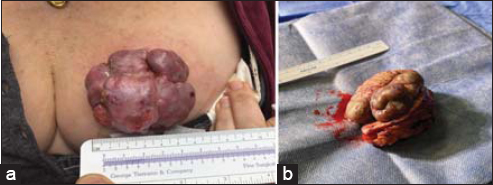A BCC masquerading as a fungating breast mass
Zachary Kolansky1, Glenn Kolansky2
1Tulane University School of Medicine, New Orleans, LA, USA, 2Director, Advanced Dermatology Surgery & Laser Center, Tinton Falls, NJ, USA
Citation tools:
Copyright information
© Our Dermatology Online 2022. No commercial re-use. See rights and permissions. Published by Our Dermatology Online.
A 55-year-old female presented with a growth on her left chest that was increasing in size. The growth had been present for several years. The patient had no complaints of pain; just concerns about the presence of the mass. Upon examination, the patient had a polypoid, lobulated, violaceous, and red fungating mask measuring approx. 7.0 cm x 6.0 cm (Fig. 1a). Malignant breast disease encompasses many histologic types that include, ductal or lobular carcinoma, infiltrating ductal or lobular carcinoma, and inflammatory carcinoma. Benign masses can include fibroadenoma, intraductal papilloma, and abscess. Patient was referred to a general surgeon for removal due to the uncertain nature of this growth (Fig. 1b). Pathology was positive for a basal cell carcinoma with focal squamous cell differentiation, nodular type (Fig. 2). All resected margins were negative. Recovery was uneventful. Basal cell carcinomas located on the trunk account for only 10 percent of all cases. The majority are in sun exposed areas such as the face and neck [1,2].
Consent
The examination of the patient was conducted according to the principles of the Declaration of Helsinki.
The authors certify that they have obtained all appropriate patient consent forms, in which the patients gave their consent for images and other clinical information to be included in the journal. The patients understand that their names and initials will not be published and due effort will be made to conceal their identity, but that anonymity cannot be guaranteed.
REFERENCES
1. Zaouak A, Bouhajja L, Hammami H, Fenniche S.Giant basal cell carcinoma. Our Dermatol Online. 2020;11:92-3.
2. Zaouak A, Bouhajja L, Rebhi F, Jouini R, Hammami H, Fenniche S. Basal cell carcinoma of the leg:an unusual location. Our Dermatol Online. 2019;10:211-2.
Notes
Source of Support: Nil,
Conflict of Interest: The authors have no conflict of interest to declare.
Request permissions
If you wish to reuse any or all of this article please use the e-mail (brzezoo77@yahoo.com) to contact with publisher.
| Related Articles | Search Authors in |
|
|





Comments are closed.